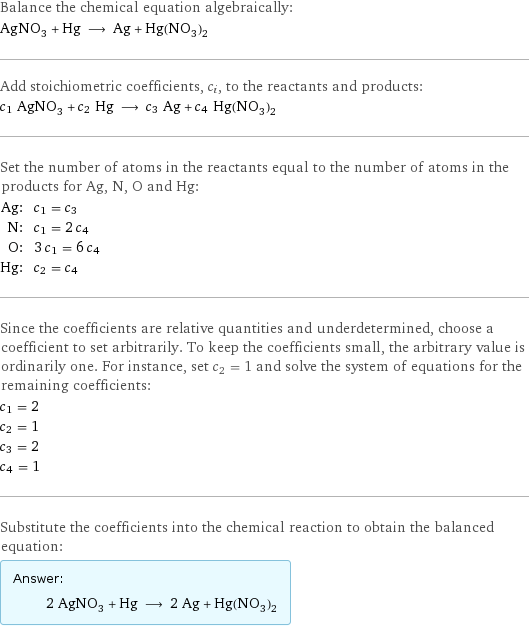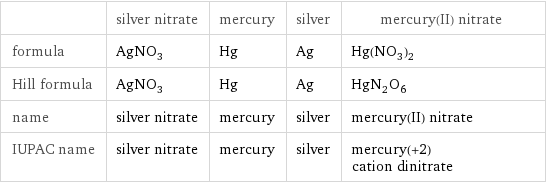Input interpretation

AgNO_3 silver nitrate + Hg mercury ⟶ Ag silver + Hg(NO_3)_2 mercury(II) nitrate
Balanced equation

Balance the chemical equation algebraically: AgNO_3 + Hg ⟶ Ag + Hg(NO_3)_2 Add stoichiometric coefficients, c_i, to the reactants and products: c_1 AgNO_3 + c_2 Hg ⟶ c_3 Ag + c_4 Hg(NO_3)_2 Set the number of atoms in the reactants equal to the number of atoms in the products for Ag, N, O and Hg: Ag: | c_1 = c_3 N: | c_1 = 2 c_4 O: | 3 c_1 = 6 c_4 Hg: | c_2 = c_4 Since the coefficients are relative quantities and underdetermined, choose a coefficient to set arbitrarily. To keep the coefficients small, the arbitrary value is ordinarily one. For instance, set c_2 = 1 and solve the system of equations for the remaining coefficients: c_1 = 2 c_2 = 1 c_3 = 2 c_4 = 1 Substitute the coefficients into the chemical reaction to obtain the balanced equation: Answer: | | 2 AgNO_3 + Hg ⟶ 2 Ag + Hg(NO_3)_2
Structures

+ ⟶ +
Names

silver nitrate + mercury ⟶ silver + mercury(II) nitrate
Equilibrium constant
![Construct the equilibrium constant, K, expression for: AgNO_3 + Hg ⟶ Ag + Hg(NO_3)_2 Plan: • Balance the chemical equation. • Determine the stoichiometric numbers. • Assemble the activity expression for each chemical species. • Use the activity expressions to build the equilibrium constant expression. Write the balanced chemical equation: 2 AgNO_3 + Hg ⟶ 2 Ag + Hg(NO_3)_2 Assign stoichiometric numbers, ν_i, using the stoichiometric coefficients, c_i, from the balanced chemical equation in the following manner: ν_i = -c_i for reactants and ν_i = c_i for products: chemical species | c_i | ν_i AgNO_3 | 2 | -2 Hg | 1 | -1 Ag | 2 | 2 Hg(NO_3)_2 | 1 | 1 Assemble the activity expressions accounting for the state of matter and ν_i: chemical species | c_i | ν_i | activity expression AgNO_3 | 2 | -2 | ([AgNO3])^(-2) Hg | 1 | -1 | ([Hg])^(-1) Ag | 2 | 2 | ([Ag])^2 Hg(NO_3)_2 | 1 | 1 | [Hg(NO3)2] The equilibrium constant symbol in the concentration basis is: K_c Mulitply the activity expressions to arrive at the K_c expression: Answer: | | K_c = ([AgNO3])^(-2) ([Hg])^(-1) ([Ag])^2 [Hg(NO3)2] = (([Ag])^2 [Hg(NO3)2])/(([AgNO3])^2 [Hg])](../image_source/1bcd01911b002fa4eefe1ad320039272.png)
Construct the equilibrium constant, K, expression for: AgNO_3 + Hg ⟶ Ag + Hg(NO_3)_2 Plan: • Balance the chemical equation. • Determine the stoichiometric numbers. • Assemble the activity expression for each chemical species. • Use the activity expressions to build the equilibrium constant expression. Write the balanced chemical equation: 2 AgNO_3 + Hg ⟶ 2 Ag + Hg(NO_3)_2 Assign stoichiometric numbers, ν_i, using the stoichiometric coefficients, c_i, from the balanced chemical equation in the following manner: ν_i = -c_i for reactants and ν_i = c_i for products: chemical species | c_i | ν_i AgNO_3 | 2 | -2 Hg | 1 | -1 Ag | 2 | 2 Hg(NO_3)_2 | 1 | 1 Assemble the activity expressions accounting for the state of matter and ν_i: chemical species | c_i | ν_i | activity expression AgNO_3 | 2 | -2 | ([AgNO3])^(-2) Hg | 1 | -1 | ([Hg])^(-1) Ag | 2 | 2 | ([Ag])^2 Hg(NO_3)_2 | 1 | 1 | [Hg(NO3)2] The equilibrium constant symbol in the concentration basis is: K_c Mulitply the activity expressions to arrive at the K_c expression: Answer: | | K_c = ([AgNO3])^(-2) ([Hg])^(-1) ([Ag])^2 [Hg(NO3)2] = (([Ag])^2 [Hg(NO3)2])/(([AgNO3])^2 [Hg])
Rate of reaction
![Construct the rate of reaction expression for: AgNO_3 + Hg ⟶ Ag + Hg(NO_3)_2 Plan: • Balance the chemical equation. • Determine the stoichiometric numbers. • Assemble the rate term for each chemical species. • Write the rate of reaction expression. Write the balanced chemical equation: 2 AgNO_3 + Hg ⟶ 2 Ag + Hg(NO_3)_2 Assign stoichiometric numbers, ν_i, using the stoichiometric coefficients, c_i, from the balanced chemical equation in the following manner: ν_i = -c_i for reactants and ν_i = c_i for products: chemical species | c_i | ν_i AgNO_3 | 2 | -2 Hg | 1 | -1 Ag | 2 | 2 Hg(NO_3)_2 | 1 | 1 The rate term for each chemical species, B_i, is 1/ν_i(Δ[B_i])/(Δt) where [B_i] is the amount concentration and t is time: chemical species | c_i | ν_i | rate term AgNO_3 | 2 | -2 | -1/2 (Δ[AgNO3])/(Δt) Hg | 1 | -1 | -(Δ[Hg])/(Δt) Ag | 2 | 2 | 1/2 (Δ[Ag])/(Δt) Hg(NO_3)_2 | 1 | 1 | (Δ[Hg(NO3)2])/(Δt) (for infinitesimal rate of change, replace Δ with d) Set the rate terms equal to each other to arrive at the rate expression: Answer: | | rate = -1/2 (Δ[AgNO3])/(Δt) = -(Δ[Hg])/(Δt) = 1/2 (Δ[Ag])/(Δt) = (Δ[Hg(NO3)2])/(Δt) (assuming constant volume and no accumulation of intermediates or side products)](../image_source/fbeddd7ce66547824aa96614cbc26ade.png)
Construct the rate of reaction expression for: AgNO_3 + Hg ⟶ Ag + Hg(NO_3)_2 Plan: • Balance the chemical equation. • Determine the stoichiometric numbers. • Assemble the rate term for each chemical species. • Write the rate of reaction expression. Write the balanced chemical equation: 2 AgNO_3 + Hg ⟶ 2 Ag + Hg(NO_3)_2 Assign stoichiometric numbers, ν_i, using the stoichiometric coefficients, c_i, from the balanced chemical equation in the following manner: ν_i = -c_i for reactants and ν_i = c_i for products: chemical species | c_i | ν_i AgNO_3 | 2 | -2 Hg | 1 | -1 Ag | 2 | 2 Hg(NO_3)_2 | 1 | 1 The rate term for each chemical species, B_i, is 1/ν_i(Δ[B_i])/(Δt) where [B_i] is the amount concentration and t is time: chemical species | c_i | ν_i | rate term AgNO_3 | 2 | -2 | -1/2 (Δ[AgNO3])/(Δt) Hg | 1 | -1 | -(Δ[Hg])/(Δt) Ag | 2 | 2 | 1/2 (Δ[Ag])/(Δt) Hg(NO_3)_2 | 1 | 1 | (Δ[Hg(NO3)2])/(Δt) (for infinitesimal rate of change, replace Δ with d) Set the rate terms equal to each other to arrive at the rate expression: Answer: | | rate = -1/2 (Δ[AgNO3])/(Δt) = -(Δ[Hg])/(Δt) = 1/2 (Δ[Ag])/(Δt) = (Δ[Hg(NO3)2])/(Δt) (assuming constant volume and no accumulation of intermediates or side products)
Chemical names and formulas

| silver nitrate | mercury | silver | mercury(II) nitrate formula | AgNO_3 | Hg | Ag | Hg(NO_3)_2 Hill formula | AgNO_3 | Hg | Ag | HgN_2O_6 name | silver nitrate | mercury | silver | mercury(II) nitrate IUPAC name | silver nitrate | mercury | silver | mercury(+2) cation dinitrate
Substance properties

| silver nitrate | mercury | silver | mercury(II) nitrate molar mass | 169.87 g/mol | 200.592 g/mol | 107.8682 g/mol | 324.6 g/mol phase | solid (at STP) | liquid (at STP) | solid (at STP) | solid (at STP) melting point | 212 °C | -38.87 °C | 960 °C | 79 °C boiling point | | 356.6 °C | 2212 °C | density | | 13.534 g/cm^3 | 10.49 g/cm^3 | 4.3 g/cm^3 solubility in water | soluble | slightly soluble | insoluble | soluble surface tension | | 0.47 N/m | | dynamic viscosity | | 0.001526 Pa s (at 25 °C) | | odor | odorless | odorless | |
Units
